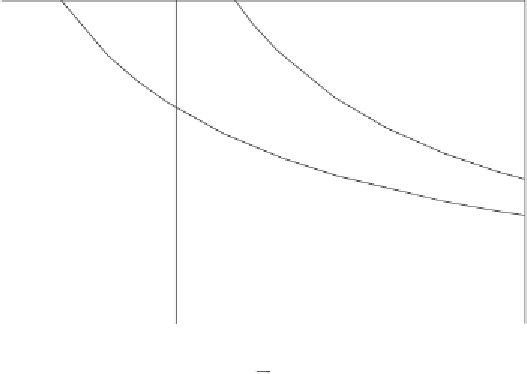Environmental Engineering Reference
In-Depth Information
0.75
p A
1
A
0
p A
A
III
p A
IV
V
1
A
0.5
0
a
p A
b
1
A
0
0.25
I
p A
c
1
A
0
II
0
0
1
2
3
a
Figure 4.9. Dependence of the shape of the probability distribution
p
(
A
) of woody
biomass
A
on parameters of the fire-vegetation dynamics. The solid curves divide the
parameter space into five zones corresponding to woodland (I), savanna (II), grassland
(III), and a bistable domain (IV) with two likely preferential states of grassland and
woodland. Zone (V) represents combinations of parameters corresponding to the
complete and permanent disappearance of woody vegetation. The properties of the
beta distribution (e.g.,
Johnson et al.
,
1994
) can be used to determine the expressions
of the solid curves: (a)
λ/
a
=
1
/α
,(b)
λ/
a
=−
1
+
1
/α
,(c)
λ/
a
=
1.
λ/
corresponds to a woodland (zone I in Fig.
4.9
). For relatively large values of
a
,the
=
mode of
A
is
A
m
0, suggesting that the system tends to be dominated by grasses
(zone III in Fig.
4.9
). Thus for most values of
α
there are two critical threshold values
of
λ/
a
marking the transitions from savanna to woodland (i.e.,
λ/
a
=
1) or to grass-
land (i.e.,
). Conditions favorable to tree-grass coexistence emerge
within a broad range of values of
λ/
a
=−
1
+
1
/α
(zone II in Fig.
4.9
). In these conditions, a sta-
tistically stable state of vegetation exists in correspondence to partial tree cover
λ
{
i.e.,
for values of
A
between 0 and 1, with
A
m
=
.
This finding supports theories of fire-induced savanna dynamics. Notice how the dy-
namical behavior of the system depends on the ratio
[
a
(1
−
α
)
−
λα
]
/
[
a
(1
−
2
α
)
+
b
α
]
}
a
, suggesting that the same
behavior can be attained with different combinations of fire frequency and tree or
shrub encroachment rates (i.e. of the parameters
λ/
and
a
).
Figure
4.9
shows also that, within a small region in the parameter space (zone
IV),
A
exhibits U-shaped probability distributions. As noted in Chapter 3, because
themodesof
p
(
A
) are preferential states of the system we interpret bimodality as a
sign of bistability, i.e., in these conditions both woodland and grassland have high
probabilities of occurrence.
λ



























Search WWH ::

Custom Search